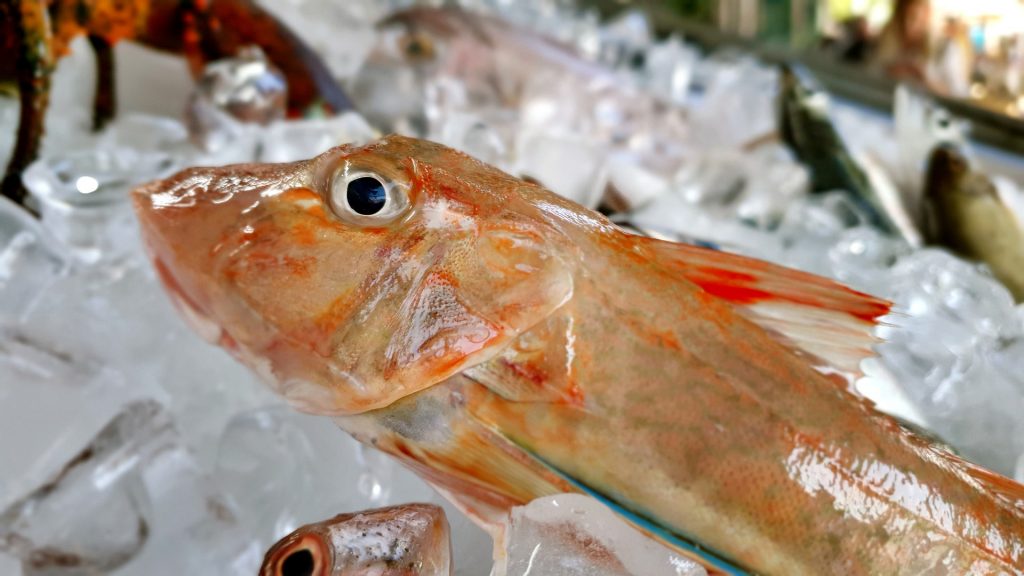Fresh vs. frozen seafood: There’s always a great debate when it comes to which type of fish is better. Many people ask, “Is frozen fish as good as fresh?” As you decide which one is going to make it to your dinner plate, you want to consider:

- Smell
- Texture
- Nutritional Value
- Flavor
As you think about these fish factors, let’s dive into the fresh vs. frozen seafood debate to help you better plan your next meal.
Table of Contents
How Fresh is “Fresh”?
When fish is advertised as fresh, how “fresh” is it really? If you’re buying fish at your grocery store, the fish may not be as fresh as you think. The fish that you see lying on that bed of ice is typically caught, frozen, shipped to a distribution center, shipped to a grocery store, and then thawed and labeled as “fresh.”
It’s not uncommon for fish to thaw and be refrozen, only to be thawed again. As you can imagine, the quality of the fish suffers during the process. When you buy your fish from the grocery store, there’s no way of knowing how long the fish was thawed before it was refrozen and then thawed again.
While fishmongers and markets often carry beautifully fresh seafood, much of what is sold is local and seasonal. For example, Dungeness crabs are caught on the West Coast, while here in North Carolina, shrimp, bluefin tuna, flounder, and catfish are great fresh options.
What if My Fish Was Flash Frozen?

Once a fish leaves the water, its quality immediately begins to deteriorate. Flash freezing is designed to stop that process. This method rapidly chills seafood to 32 degrees Fahrenheit and then flash freezes it at -20 degrees. The process coats the fish in a protective layer of ice that prevents cellular breakdown and ensures the best quality, even through transportation, storage, and distribution.
By contrast, the slower seafood freezes, the larger the ice crystals that form between the fibers of the fish’s proteins. These large crystals impact the fish’s texture and taste, which is why flash freezing is so valuable.
This process is why, in many cases, frozen fish can be just as good as fresh when handled properly.
What to Look for in Fresh and Frozen Seafood
When you’re deciding between fresh and frozen seafood, you want to let your senses be the judge.
Smell
Fresh seafood shouldn’t have a strong or “fishy” scent. A clean, sea-like smell indicates freshness. Anything with an unpleasant odor is a red flag.
Texture
Filets and steaks should look moist, firm, and fresh. Avoid any that look dry or have an excess of liquid. For whole fish, look for shiny skin, cherry-red gills, and clear eyes. For shellfish, clean, closed shells are a sign of freshness. Also, look for labels indicating the fish was caught in America.
Nutritional Value
Freezing fish does not reduce its nutritional content. Protein, fat, and vitamins remain intact, although thawing can reduce some water content, which carries water-soluble vitamins and minerals. Using any liquid released during cooking can help retain those nutrients. Fresh fish, on the other hand, doesn’t lose water content, so all of its nutrients remain intact.
Flavor
Frozen fish can lose some flavor over time. According to the USDA, frozen raw fish is best used within 3–8 months, while shellfish are best within 3–12 months. If you see freezer burn, it’s time to toss it.
Storing Fresh Seafood
Storing fresh seafood is simple: keep it wrapped in moisture-proof paper or in an airtight container to prevent leaks and exposure to air. Refrigerate it and use it soon after buying—preferably the same day.
Storing and Defrosting Frozen Seafood
To store frozen seafood, place it in your freezer kept at zero degrees. Some fish, like halibut, cod, and salmon, can be stored for up to four months, while more delicate options are best used sooner.
When you’re ready to use it, thaw fish by putting it in your fridge for 8 to 10 hours before you plan to cook it. Keep it wrapped in its packaging and place it on a plate or shallow pan to catch any liquid.
While chicken and beef can be thawed in a microwave or in cool water, don’t try to do this with fish or seafood. You’ll lose both flavor and texture.
Looking for Fresh Seafood? Visit NC Seafood Today!
If you want a delicious, made-to-order seafood dinner, let us do the cooking! From Calabash-style catfish to broiled flounder, NC Seafood prepares every dish with care and flavor in mind. Come by for lunch or dinner at the Farmer’s Market in Raleigh, or check out our menu and order online for pick up. You won’t be disappointed!
